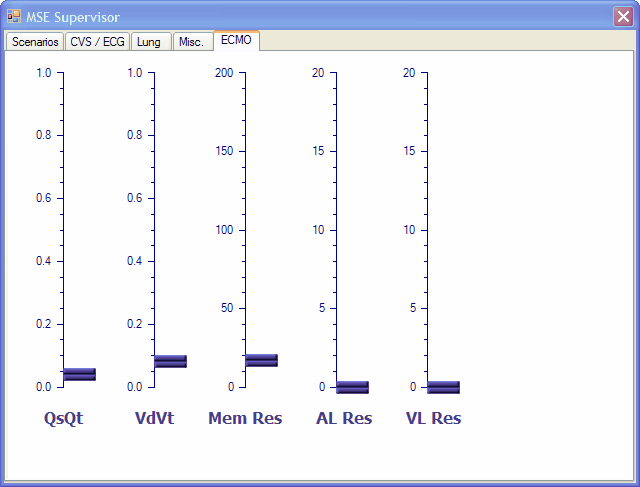The <ECMO> page of the supervisory application is used to make adjustments to the ECMO system.

The <QsQt> slider is used to set the 'shunt fraction' of the oxygenator at a nominal blood flow of 3.0 lpm. According to Segers et al, the best-performing oxygenators (in 2001) had shunt fractions of ~ 0.08 at this flow rate. If you wish to simulate complete gas transfer failure, push the <QsQt> slider to 1.0. Simulate partial failure by placing it around 0.5. The system automatically varies shunt fraction according to blood flow rate.
The <VdVt> slider is used to set the 'Dead Space' of the oxygenator at a nominal blood and gas flow of 3.0 lpm. Some work by Pybus et al suggest that a value of ~0.08 - 0.10 is representative. If you wish to simulate complete disconnection of the gas supply, push the <VdVt> slider to 1.0. The system automatically varies dead space according to blood and gas flow rate.
The <Mem Res> slider is used to set the Membrane Resistance of the oxygenator. The scale represents the pressure drop across the oxygenator in mm Hg/L/min. Typically, the value of this parameter is in the range 10 - 30 mm Hg/L/Min for a noramally-functioning oxygenator.
The <AL Res> slider is used to set the resistance of the arterial (return) line. The scale represents the pressure drop across the 'Arterial' line in mm Hg/dL/min. Typically, the value of this parameter is < 1 mm Hg/L/Min for unobstructed tubing. If you wish to simulate more-or-less complete kinking of the 'arterial' line, set the <AL Res> slider to 20.
The <VL Res> slider is used to set the resistance of the venous (drainage) line. The scale represents the pressure drop across the drainage line in mm Hg/dL/min. Typically, the value of this parameter is < 1 mm Hg/L/Min for unobstructed tubing. If you wish to simulate more-or-less complete kinking of the drainage line, set the <VL Res> slider to 20.